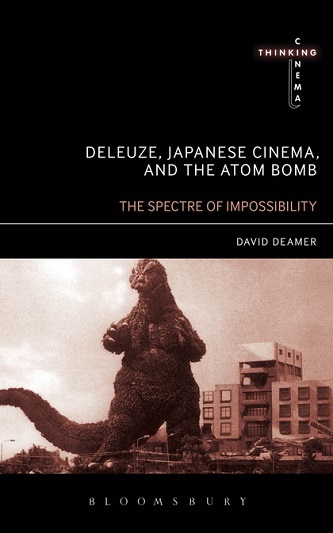Deleuze, Japanese Cinema, and the Atom Bomb: The Spectre of Impossibility (Bloomsbury, 2014)

Deleuze, Japanese Cinema, and the Atom Bomb establishes the first ever sustained encounter between Gilles Deleuze’s Cinema books and post-war Japanese cinema, exploring how Japanese films responded to the atomic bombings of Hiroshima and Nagasaki. From the early days of occupation and political censorship to the social and cultural freedoms of the 1960s and beyond, the book examines how images of the nuclear event appear in post-war Japanese cinema.
Using Deleuze’s taxonony of cinema, each chapter begins by focusing upon one or more of three key Deleuzian themes – image, history and thought – before going on to look at a selection of films from 1945 to the present day. These include movies by well-known directors Kurosawa Akira, Shindo Kaneto, Oshima Nagisa and Imamura Shohei; popular and cult classics – Godzilla (1954), Akira (1988) and Tetsuo (1989); contemporary genre flicks – Ring (1998), Dead or Alive (1999) and Casshern (2004); the avant-garde and rarely seen documentaries. A series of tables clarify the conceptual components deployed within the text; and each film is illustrated with a number of stills.
Reviews
This ambitious book brings together three different constellations: the national cinema of Japan; the atom bombs thrown on Hiroshima and Nagasaki; and Deleuze. Surprising though this may sound, the book patiently and expertly weaves these three strands together to the point of making us feel that the Deleuzian cineosis was conceived to address precisely this kind of historico-cinematic encounter. Moving away from reductive ideas of genre, Deamer tackles the complexity of a wide and extremely varied body of films united by the catastrophe of the atom bomb, allowing for a re-evaluation of forgotten gems as well as celebrated masterpieces. Unveiling not one but many Japans, this book testifies to the enduring power and infinite uses of Deleuze’s vision of cinema.
Lúcia Nagib, Professor of Film, University of Reading, UK (Review for Bloomsbury)
Deamer’s study is exemplary in its interweaving of film and philosophy. From a philosophical perspective, the book provides a clear, rigorous, and concrete reading of Deleuze’s semiotics of cinema and its philosophical grounds. From a cinematic perspective, the book provides a fascinating, detailed study of Japanese cinema, demonstrating the continuing importance of the event of Hiroshima. It provides a thoroughly convincing case for the importance to Japanese cinema of the atom bomb, and the importance to the analysis of cinema more generally of Deleuze’s philosophy of film. Highly recommended.
Henry Somers-Hall, Senior Lecturer in Philosophy, Royal Holloway, University of London, UK (Review for Bloomsbury)
In a 30-page introduction… Deamer… lays out Deleuze’s theory of cinema, found in his Cinema I and Cinema II… then uses Deleuze’s tool kit to extract the possibilities of meaning from post–WW II Japanese war films. Possibilities is key: Deamer says Deleuze’s theory is broad enough to allow for a variety of readings, even contradictory ones. Other chapters explore those possibilities in films that treat the atom bomb directly (The Effects of the Atomic Bomb on Hiroshima and Nagasaki, 1946; I Live in Fear, 1955; Black Rain, 1989) but in different Deleuzian categories. In his analysis of Godzilla, 1954, Deamer suggests that the monster is a representation not of barbaric bomb users but of Japanese imperial power, turned monstrous in the 1930–1940s… Deamer devotes one chapter to four Kurosawa films… Readers will find Deamer’s analysis of Rashomon, 1950, both interesting and surprising… Recommended. Graduate students, researchers, faculty.
Professor Robert Ducharme, Mount Saint Mary’s University, in Choice: Current Reviews for Academic Libraries, volume 52 issue 5, 2014
The Spectre of Impossibility is a well written, clear, insightful and always to-the-point examination of the ways in which Japanese cinema has (and has not) dealt with the atomic bombs… [I]t is the first English language book to properly delve into this subject matter, and I congratulate Deamer for both the depth and the breadth with which he approaches this challenging topic… The challenge is the conceptual framework that Deleuze created for cinema and which, it is my understanding, Deamer not only employs but also extends in this book. Yet, while this framework is definitely an integral part of the book, it should actually be possible to read it and let some of the details of the conceptual theory wash over you while concentrating primarily on the conclusions that Deamer draws in his discussion. This is thanks to the insights that the author has for each film that he discusses, and which alone are worth the admission price.
Vili Maunula at Akira Kurosawa info (2016).
Like Deleuze, Deamer treats films as cinematic signs that ‘are little machines used to connect images and to connect films in order to produce readings’, concentrating on a ‘heterogeneous assemblage’ of fragments, images and films, and linking and relinking them as they configure and reconfigure the different types of image propounded by Deleuze’s theory of signs… There is something original and compelling in the way the book is structured around three distinct yet overlapping axes, connecting Japanese cinema to the nuclear event through the Deleuzian model… Deamer… builds on [Lúcia] Nagib’s notion of polycentrism in order to justify his method… This is an unusual reading of Deleuze’s books. That said, viewed as a passionate Deleuzian project, Deleuze, Japanese Cinema and the Atom Bomb is impressive in its scope and delivers what it sets out to do with brio. It will not disappoint the Deleuzians.
Dr Tiago de Luca, Assistant Professor in Film & Television Studies, University of Warwick in Screen (Autumn 2016) 57 (3): 383-387